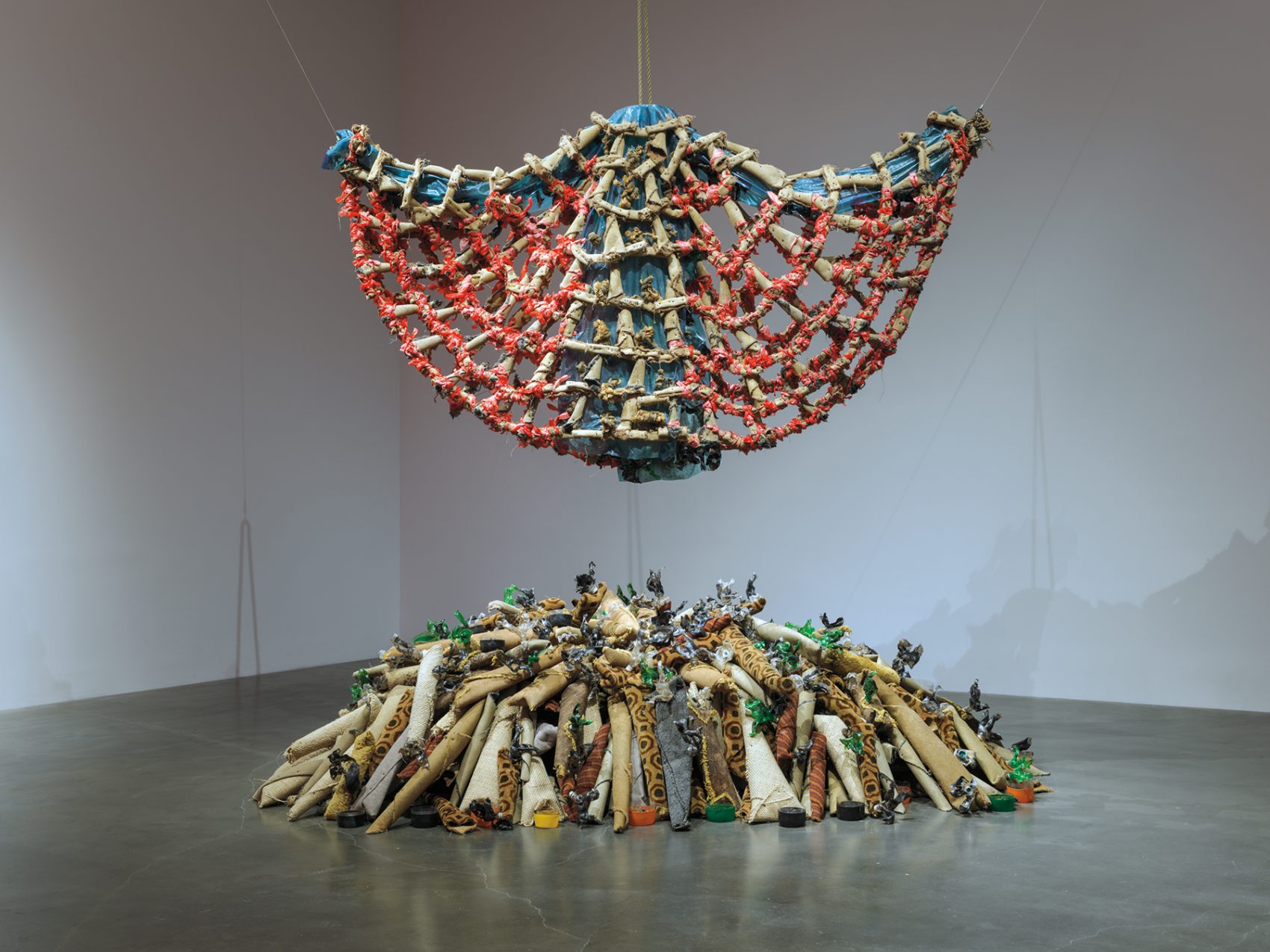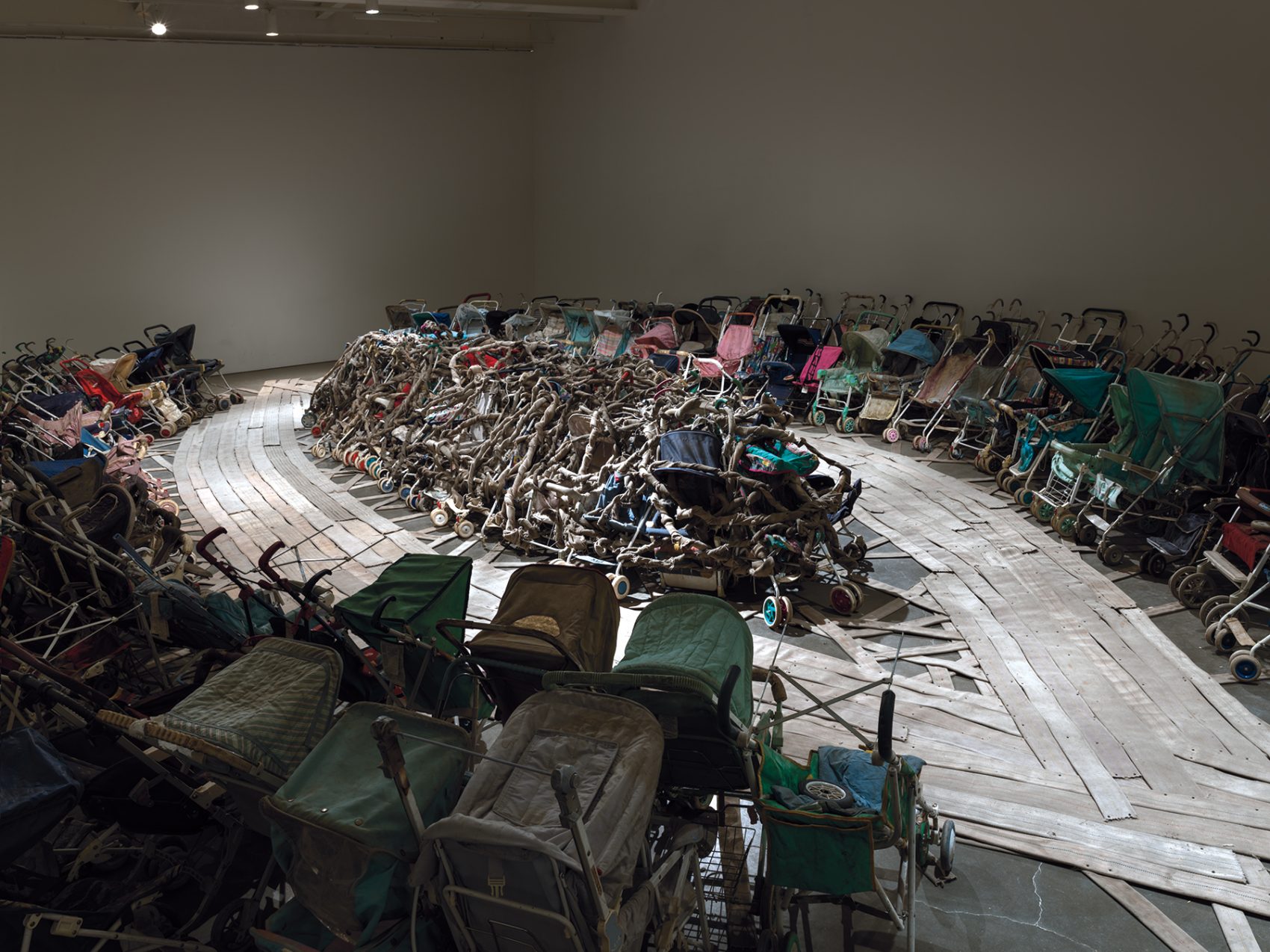
Nari Ward: We the People, installation view, New Museum, New York, February 13-May 26, 2019. Photo: Maris Hutchinson/EPW Studio.
Since 2007, the “new” New Museum has stood directly opposite the Bowery Mission. The mission was founded in 1879 to provide food, shelter, clothing, and spiritual support for the homeless men, women, and children living in the area. One of the largest Christian missionary institutions on the East Coast, the Bowery Mission is also one of the few remaining organizations on the Lower East Side that continues to serve a population of people struggling to stay afloat in New York’s increasingly expensive real estate and rental market. The geographical proximity between the two institutions offers a productive framework for thinking about Nari Ward’s recent exhibition at the New Museum, titled We the People. For three decades, Ward has been a scavenger of the charged remnants of other people’s lives. His staggering assemblages of abandoned baby carriages, fire hoses, baseball bats, shoelaces, and oven racks sensitively recuperate objects abandoned by their owners. Ward’s identity as a Jamaican immigrant, combined with his long-time residence in Harlem and his relationship to neighborhoods like the Bowery that have become vulnerable to predatory developers, brings particular significance to his process and to his exhibition at this site.
In an era when commercial developers have seized Manhattan and transformed it into an exploratory ground for capitalist ventures and market gains, Ward’s midcareer survey, curated by Gary Carrion-Murayari, Massimiliano Gioni, and Helga Christoffersen for the New Museum, could be viewed as a subversive, anti-gentrifying manifesto within the art institution. This presentation of the artist’s thirty-year commitment to reimagining urban detritus as art fills three entire floors of the New Museum and includes over thirty sculptures, paintings, videos, and large-scale installations created through Ward’s practice of finding, accumulating, and repurposing abandoned materials. The exhibition highlights the range of aesthetic and social concerns—such as immigration, racism, and national belonging—that have marked the trajectory of his practice.

Nari Ward: We the People, installation view, New Museum, New York, February 13-May 26, 2019. Photo: Maris Hutchinson/EPW Studio.
We the People, which presents many of the most significant works of Ward’s career to date, directs attention to the unfolding of important stylistic attributes and strategies that resonate with a history of found-object practices and architectural interventions that emerged in the 1970s and gained visibility in the art mainstream in the 1990s. One powerful example of this is Ward’s Carpet Angel (1992), which has not been exhibited since Ward’s first solo show at the New Museum in 1993. This mixed-media installation combined busted furniture and plastic waste gathered from his Harlem neighborhood with decomposing carpet pieces from the apartment/ studio he was occupying at the time. The artist assembled these objects into a set of wings suspended above a heaping pile of debris. This work established Ward as an artist invested in the ways discarded objects maintain their connections to the material world and the stories they carry within them. His creative practice is bound to a diversity of cultural modes of production—from folk traditions of the African diaspora in the Southern United States and Jamaica to the assemblage sculptures of African-American artists on the West Coast to the twentieth-century European avant-garde. This range of influences attests to the artist’s engagement with a variety of historical frameworks, material economies, and social phenomena present in developing and socioeconomically precarious locales.
The title of the exhibition, We the People, comes from Ward’s 2011 work of the same name, which consists of thousands of multicolored shoelaces hung from the gallery wall. Collectively, the shoelaces spell out the first three words of the preamble to the United States Constitution. Made in collaboration with the Fabric Workshop and Museum in Philadelphia—in the city where the Declaration of Independence was signed in 1776 and the Constitution was written in 1787—We the People celebrates and interrogates the framing of that statement. In the individual thread-bodies that make up “the people,” we become aware of the kinds of exclusions and exceptions to belonging that conspire to cast out groups from the body politic. We also see the possibilities inherent in gathering together. As the artist describes it, “[I] highjack signs that we don’t see, or stop seeing, or don’t think about as much” as a strategy for recovering “what we take for granted.”1 With this quote, Ward points to the preamble’s radical potential as a truly inclusive founding identity of Americanness and to the antidemocratic modes of exclusion that have marked its history.
Hunger Cradle (1996–ongoing), a monumental site-specific work that opens the exhibition, epitomizes Ward’s process of transforming objects into stand-ins for the bodies of marginalized people. First presented in 1996—as part of 3 Legged Race, a group exhibition of the work of Ward, Janine Antoni, and Marcel Odenbach in a nineteenth-century firehouse in Harlem—Hunger Cradle is reinstalled here with newly scavenged items. In a vast and tangled net of rope and multicolored yarn looming just above the viewer’s head hangs an assortment of found domestic objects, including broken furniture, outdated technological devices, a child’s crib, and tools. The knotty sculpture of interwoven lines and objects could be seen as a counter-response to Marcel Duchamp’s cat’s cradle string installation, his twine (1942), which infamously turned the bourgeois setting of the exhibition First Papers of Surrealism into a frustrating maze of perceptual and kinesthetic obstacles. Ward’s cast-offs are suspended in a liminal state of purgatory, nested together, as citizens of neither the world nor the heavens. These discarded items hanging out above us subvert our ability to simply classify the discarded items as icons of abjectness. Ward’s insistence on their presence, whether hovering over our heads or just out of view, produces a sense of home as insecure.
The exhibition includes many of Ward’s stand-alone sculptures, including Savior (1996) and Crusader (2005), which are made from abandoned vendor carts, strollers, and shopping carts. These sculptures embrace what is left over—bruised and scuffed remnants of the throw-away consumerism that marks our era. Ward collects these objects, which are often used as temporary homes for the homeless, and arranges them in delicately balanced totems. These dynamic assemblages made up of “low” materials—precarious monuments to precarious lives—harness the life-affirming history of Black resilience, creativity, and spiritual power in spite of centuries of colonial violence, racism, economic exploitation, and generational trauma inflicted upon Black bodies and communities. As Bennett Simpson argues, Ward reverses the power flow present in Western modernism that allowed white artists to appropriate (and therefore romanticize and domesticate) the visual forms and cultural contexts of non-white artists and communities in their quest for a more authentic art. Ward instead engages in embalming, honoring, nurturing, and spiritualizing these objects and the inferred experiences of ordinary beings, and he demands that we engage with Black art historical contexts, such as the scavenging practices of John Outterbridge, the transformative processes of culturally coded Black symbols and objects in the work of David Hammons, the recontextualization of debris from Los Angeles race riots in the work of Noah Purifoy, and the mystical iconographic assemblages of Betye Saar.2

Nari Ward: We the People, installation view, New Museum, New York, February 13-May 26, 2019. Photo: Maris Hutchinson/EPW Studio.
Amazing Grace (1993), Ward’s large-scale, multisensory response to the AIDS and drug crises that ravaged communities of color in New York in the 1990s, is the apotheosis of the exhibition’s methods and themes. The chilling assemblage, composed of over 300 broken and battered strollers corralled by a web of found firehoses, conjures the absent mothers, fathers, and children—homeless and otherwise—that once pushed these abandoned baby carriages. Mahalia Jackson’s resounding voice fills the large gallery that is dedicated solely to this work with “Amazing Grace,” the iconic hymn written by a former slave owner who later became an anti-slavery abolitionist. Aural, visual, tactile, and even olfactory qualities (the smell of decomposing plastics from the firehoses and strollers in the room is overwhelming) combine in a veritable gesamtkunstwerk—a total work of art—for those lost to drugs and AIDS in urban, predominately Black and Latino communities; the genocide brought on by the transatlantic slave trade; the thousands of migrant and refugee deaths of the past and present; and the countless young Black men and women whose lives are ended or irrevocably altered by police violence.
Ward is vigilant about keeping his oeuvre open to new interpretations and contexts, and the New Museum exhibition provides links between the conditions of New York in the 1980s and 1990s and our current era. These echoes are found in the work’s interrogation of what it means to be Black, poor, and struggling to survive in a society where life takes place in the streets, an encounter with police can be a death sentence, serious jail time may be just one misstep away, and the social safety net for minorities is intentionally bankrupt. In this view, the streets are not only places where those without resources conduct their lives, they are also the spaces where those lives and the lives of other vulnerable populations are violently interrupted or destroyed. Resurrected in an era of Black Lives Matter, Ward’s sculptures seem to call out an increasingly emboldened white supremacy movement that is supported by the Trump administration, the rise of which dates back to Trump’s time as a New York City landlord in the 1980s and 1990s and his well-documented discriminatory practices against Black tenants and Black youth.

Nari Ward: We the People, installation view, New Museum, New York, February 13-May 26, 2019. Photo: Maris Hutchinson/EPW Studio.
The seven-minute video Pushing Savior (1996), filmed by Marcel Odenbach, documents Ward pushing his monumental sculpture Savior down the sidewalks of Harlem as passersby look on with varying expressions of shock, awe, and indifference. Ward’s procession, marked by long strides and heavy breaths, is both ceremony and political protest. The film records the grandiose scale and material awkwardness of the sculpture and the artist’s exhaustion from the effort to deploy his relic to homelessness in public space. As Ward struggles to control the sculpture, onlookers ignore him or call out jokes. The message appears to be that one must indeed push for change and possibly exhaust oneself in order to restore humanity and dignity to those forgotten by society.
Jordan Amirkhani is an art historian, educator, critic, and curator based in Washington, DC, and is currently a Professorial Lecturer in Modern and Contemporary European and American Art at American University. Amirkhani is a regular contributor to a number of national and international contemporary art publications, including Artforum, Baltimore Arts, Burnaway.org, and Number, Inc.
